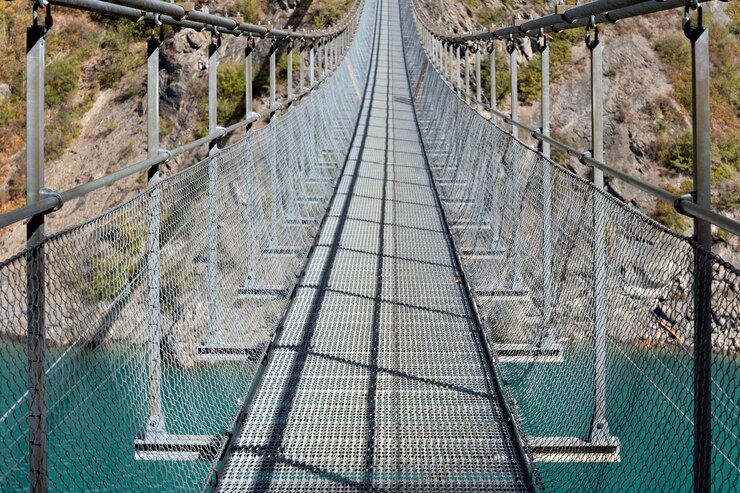The Anji Khad Bridge, India’s first cable-stayed rail bridge, is now complete, marking a significant achievement in Indian rail infrastructure. This engineering marvel is a crucial component of the Udhampur-Srinagar-Baramulla Rail Link (USBRL) project, designed to enhance connectivity in Jammu & Kashmir. The bridge not only stands as a testament to India’s engineering excellence but also as a transformative step towards modernizing regional infrastructure.
Key Features of the Anji Khad Bridge
The Anji Khad Bridge spans the mighty Anji River in Jammu & Kashmir, boasting a state-of-the-art cable-stayed design.
Design Excellence: With a central span of 725.5 meters and pylons soaring to 193 meters, the bridge is a visual and functional masterpiece. From the river bed it soars about 331 metres above.
Robust Construction: It can withstand high winds and seismic activity, ensuring safety and durability in the region’s challenging conditions. Its design allows it to withstand the wind speed of around 213km/h and train can operate upto 100km/h.
Structural Marvel: The bridge comprises 96 cables, each meticulously placed to provide stability and balance. The bridge is constructed in challenging terrains of Himalayas, the bridge overcame various complex geological conditions as well.
This cutting-edge design positions the Anji Khad Bridge as an architectural icon in India’s rail infrastructure landscape. Overall bridge comprises 4 parts: 120 metres viaduct on the Reasi side, 38 metres approach bridge on the Katra side, 473 metres of cable bridge part spanning in the valley and 94 metres of central embankment which connects main structure to viaduct.
The bridge construction involves 92 cables which range from 82 to 120 metres. Hybrid foundation was used to stabilize the pylon. Bridge is equipped with an integrated monitoring system with sensors to ensure the structural integrity of the bridge.
Strategic Importance
Strategically located between Katra and Reasi, the Anji Khad Bridge plays a pivotal role in the USBRL project.
Regional Connectivity: It bridges a critical gap in the rail link, making travel between Jammu and Kashmir seamless.
Economic Boost: Improved connectivity is expected to spur local trade, tourism, and economic development.
National Security: The bridge enhances logistical support to strategically sensitive areas in Jammu & Kashmir, reinforcing India’s infrastructure preparedness.
Technological Innovations
The Anji Khad Bridge incorporates advanced engineering techniques to tackle the region’s geographical challenges.
Innovative Construction: Engineers employed high-tensile cables and specialized materials to ensure structural integrity. Spanish imported tower cranes were used to reduce construction time by 30%.
Global Expertise: Both Indian and international experts collaborated on the design and execution of this landmark project. Design and supervision of the project was handled by Italian firm ITALFERR with proof-checking by UK’s COWI. Indian engineering codes were combined with Eurocodes to improve Bridge design.
These innovations not only underline India’s growing expertise in infrastructure development but also pave the way for future projects of this scale.
Challenges Faced During Construction
Building the Anji Khad Bridge was no small feat.
Terrain Difficulties: The steep gorges and uneven terrain of the Anji River Valley posed significant challenges.The rough terrains of Himalayas don’t give a very ideal base for the bridge’s foundation but with Hybrid foundation this problem was solved.
Climatic Constraints: Harsh weather and frequent landslides delayed progress multiple times. The wind blows in Anji River Valley can vary upto 100 km/h to more but with cable suspension we try to solve this problem. Due to which this bridge can easily survive the winds upto 200km/h.
Resource Management: Transporting materials to such a remote location required meticulous planning and execution.
Despite these hurdles, the project reached completion thanks to relentless determination, advanced technology, and expert planning.
Benefits to Regional Infrastructure
The completion of the Anji Khad Bridge is a turning point for the infrastructure in Jammu & Kashmir.
Tourism Potential: With enhanced connectivity, the region is set to witness a surge in tourism, boosting local businesses.
Economic Growth: Improved access to markets and resources is expected to uplift the region’s economic landscape.
Safety and Efficiency: The bridge provides a safer and faster alternative to road transport in the challenging terrain.
Role of Anji Khad Bridge in India’s Rail Infrastructure
The Anji Khad Bridge is a milestone in India’s journey toward modern rail infrastructure.
Future Projects: It sets a benchmark for cable-stayed bridges, paving the way for similar projects across the country.
Engineering Milestone: The successful completion of this project underscores India’s capability to undertake complex infrastructure ventures.
National Connectivity: The USBRL project, with Anji Khad Bridge as a crucial component, aims to integrate the northernmost region into India’s mainstream transport network.
Conclusion
The completion of the Anji Khad Bridge symbolizes India’s progress in rail infrastructure, demonstrating engineering brilliance and strategic vision. As part of the USBRL project, the bridge promises to transform connectivity, boost the region’s economy, and enhance the nation’s infrastructure capabilities. This landmark project underscores India’s commitment to creating resilient and modern infrastructure to meet the demands of the future. The project is final but waiting for the clearance and inspection by Commisioner of Rail Safety (CRS).
